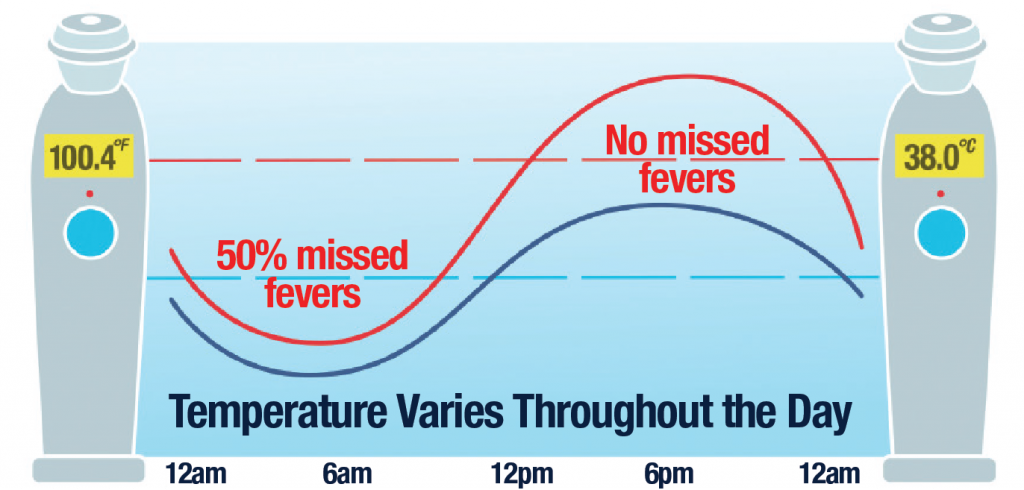
New study shows fever in the morning is rare
Now that cities and businesses are slowly opening up new procedures are being designed to ensure that people can safely travel and work. One of the measures transportation companies like airlines and railroads but also employers are likely to use is screening anyone entering their facilities and buildings. Researchers say we should be careful with screening for fever during morning hours. Why? Because a new study shows fever-range temperatures are rarest in the morning.
Half as common
Fever-range temperatures occur about half as common during mornings as during evenings. That is one of the conclusions researchers come to in a new study called ‘Fever Are Rarest In The Morning: Could We Be Missing Infectious Disease Cases by Screening for Fever Then?’. In the study researchers have retrospectively investigated fever-range temperatures (≥ 100.4 oF or ≥ 38,0 oC) during seasonal influenza outbreaks and the 2009 H1N1 (swine flu) pandemic. These same data sets have recently been used as preparatory models for the COVID-19 pandemic. The analyses included data from a nationally representative sample of records from adult visits to US emergency departments and data from a Boston based emergency department.
Are morning temperatures less diagnostic?
Temperature screenings are frequently being used for COVID-19 because measuring body temperature is an easy procedure. Also fever is often an early-warning signal that someone might be ill or is contaminated.
New procedure necessary
Currently fever screening is usually recommended once daily at morning arrival. But this study suggests this might not be enough. The morning hours might even be “the worst time” for screening visitors and employees for fever, the researchers state in a discussion of their results. They suggest a new procedure where people are measured at both start and end of their shift or workday. During extended shift we should look at taking temperature at least every 12 hours.
How does an adjusted temperature measurement procedure work?
The first measurement would make it possible to screen and detect cases before the shift or workday starts. The second screening would help catch cases previously missed.
The researchers reason that by following this two-step approach at least one measurement avoids the temperature low point, regardless of differences in shifts or individual circadian timing.
Useful when testing is not possible
This approach solves the problem of the rare occurrence of fever during mornings. It might also be a good solution in those cases where testing for COVID-19 is for some reason not possible. In those cases a second temperature reading of the body temperatures of individuals already screened during the morning hours might be requested.
Airlines and railroads
The same approach is useful for longer flights. For airlines and railroad companies a procedure where temperature is being measured before departure and after arrival might help catch previously undetected COVID-19 cases.
In cases where it is not possible to screen individuals twice and all measurements have to take place during the morning the researchers also suggest an alternative procedure might be an adjusted definition of the term ‘fever’. That would obviously require developing and validating a new temperature definition. Also, it would not take into account the circadian timing differences between individuals.
Easy of use and accuracy is key
The researchers end their study with some helpful remarks. The findings of their study are only relevant when the measurements are being dong with a hospital-grade thermometer like the Temporal Artery Thermometers designed and manufactured by Exergen Corporation. They also state that many consumer- grade thermometer guns and thermal imagers are simply not accurate enough to be able to detect the differences in body temperature. Which might imply that they consider a hospital-grade thermometer, like the TAT-2000(C) or TAT-5000, which is a far better tool for fever detection purposes.
Additionally the researchers state that many thermometers like guns and imagers are too difficult to operate and produce results that are not accurate and do not give a good indication of the actual body temperature. This is a pro for the TAT-2000(C) and TAT-5000 as well, because operating these thermometers is very easy – even for inexperienced individuals like airline workers.
A last remark is that so far the study of COVID-19 has not shown the occurrence of a low temperature during morning hours. Nevertheless, the researchers hope that the results of their study helps employers, public health authorities, transportation companies and others to find an optimal balance between false-positives and false-negatives when it comes to temperature measurements during the COVID-19 pandemic.
